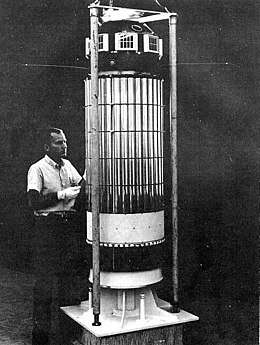Explorer 23
 S-55 model | |
| Mission type | Earth science |
|---|---|
| Operator | NASA |
| COSPAR ID | 1964-074A[1] |
| SATCAT no. | 924 |
| Mission duration | 1 year |
| Spacecraft properties | |
| Launch mass | 133.8 kg (295 lb) |
| Start of mission | |
| Launch date | 6 November 1964, 12:00 UTC[2] |
| Rocket | Scout X-1 |
| Launch site | Wallops LA-3 |
| End of mission | |
| Last contact | 7 November 1965 |
| Decay date | 29 June 1983 |
| Orbital parameters | |
| Reference system | Geocentric |
| Regime | Low Earth |
| Eccentricity | 0.0294[1] |
| Perigee | 451 km (280 mi)[1] |
| Apogee | 865 km (537 mi)[1] |
| Inclination | 51.90°[1] |
| Period | 97.9 minutes[1] |
| Epoch | 6 November 1964[1] |
Explorer 23 (also called S-55C) was an American satellite launched as part of Explorers program of the NASA. Explorer 23 was part of series S-55, being the last.
Explorer 23 micrometeoroid satellite was the third in the series of S 55 micrometeoroid satellites orbited by NASA. Its purpose was to obtain data on the near-earth meteoroid environment, thus providing an accurate estimate of the probability of penetration in spacecraft structures by meteoroids and allowing a more confident definition of the penetration flux-material thickness relation to be derived.
The cylindrically shaped spacecraft, about 61 by 234 centimetres (24 in × 92 in), was built around the burned out fourth stage of the Scout launch vehicle, which remained as part of the orbiting satellite. Explorer 23 carried stainless steel pressurized-cell penetration detectors, impact detectors, and cadmium sulfide cell detectors to obtain data on the size, number, distribution, and momentum of dust particles in the near-earth environment. In addition, the spacecraft was designed to provide data on the effects of the space environment on the operation of capacitor penetration detectors and solar cell power supplies. The spacecraft mass, neglecting the fourth stage vehicle hardware and motor, was 96.4 kilograms (213 lb).
The spacecraft operated satisfactorily during its 1 year life (November 6, 1964, through November 7, 1965), and all mission objectives were accomplished, except for the cadmium sulfide cell detector experiment, which was damaged on liftoff and provided no data.[1]
.png)